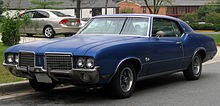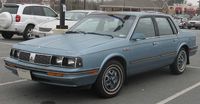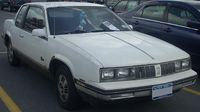- Oldsmobile Cutlass
-
Oldsmobile Cutlass Manufacturer General Motors Production 1961–1999 Predecessor Oldsmobile Cutlass Ciera (for 1997) Successor Oldsmobile Cutlass Ciera (for 1982)
Oldsmobile Alero (for 1999)Class Compact (1961–1963)
Mid-size (1964–1981, 1997–1999)The Oldsmobile Cutlass is a line of automobiles made by the Oldsmobile division of General Motors. The Cutlass began as a unibody compact car, but saw its greatest success as a body-on-frame intermediate car.
Introduced in 1961 as the top trim level in Olds' compact F-85 line, over the years the Cutlass name accumulated great brand equity, and became one of the most popular nameplates in the industry in the 1970s.[citation needed] By the 1980s, Oldsmobile was using the Cutlass as a sub-marque, with a number of different vehicle lines bearing the name simultaneously. These included the Cutlass Calais compact, the midsize Cutlass Ciera, the Cutlass Cruiser station wagon, and the premium midsize Cutlass Supreme.
Contents
Origins of the Cutlass
The first Oldsmobile Cutlass was an experimental sports coupe designed in 1954. It rode a 110 in (2,800 mm) wheelbase, and had a dramatic fastback roofline, with a stock V8. Its platform was quite similar to the later compact F-85, which was not introduced for seven more years.
First-generation compact
First generation 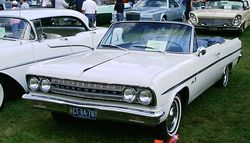
Also called Oldsmobile F-85 Production 1961–1963 Body style 4-door sedan
2-door coupe
2-door hardtop
4-door station wagonLayout FR layout Platform A-body Engine 215 cu in (3.52 L) V8 Transmission 3-speed Roto Hydramatic
3-speed manualWheelbase 112 in (2,800 mm)[1] Length 192.2 in (4.88 m) General Motors began developing its first compact cars in 1956, beginning with the Chevrolet Corvair. The following year a second series of somewhat larger cars was planned for Buick, Oldsmobile, and Pontiac, what would be termed "senior compacts." They would share the same body shell and lightweight engine. Oldsmobile designer Irving Rybicki began work on the Olds model in 1957. It finally went on sale in 1960 as a 1961 model.
The Oldsmobile, dubbed F-85, shared a new A-body platform, using a 112 inch (2845 mm) wheelbase and still-novel unibody construction, with the Buick Special and Pontiac Tempest. It was Oldsmobile's smallest, cheapest model – some two feet (60 cm) shorter and $451 cheaper than the next-smallest Olds. The F-85 had double wishbone front suspension and a four-link live axle in the rear, suspended with coil springs all around. Standard engine was the new small V8, all aluminum, displacing 215 cu in (3.5 L). With a two-barrel carburetor, it was rated 155 bhp (115.6 kW) and 210 pound force-feet (280 N·m). Transmission options were initially three-speed manual or the newly introduced three-speed Roto Hydramatic. The F-85 had drum brakes of 9.5 inches (240 mm) diameter. Overall length was initially 188.2 inches (4,780 mm), and curb weight was around 2,800 pounds (1,300 kg).
1961
The first-year F-85 was offered as a four-door sedan in base or Deluxe trim, or a four-door station wagon with either two or four seats, in base or Deluxe form. Initial sales were somewhat disappointing, but were soon picked up by the May introduction of a two door sedan and the Cutlass sports coupe (a pillared two-door for 1961 which became a pillarless "hardtop" for 1962) sporting unique trim, an interior with bucket seats and optional center console, and a four-barrel version of the V8 engine, rated at 185 horsepower (138 kW). This engine was optional on other F-85s, as was a four-speed manual transmission. 80,347 F-85s were built in total. It used a full perimeter frame.[2]
Car Life magazine tested an F-85 with the standard engine and automatic transmission, and recorded a 0-60 (0–96 km/h) time of 14.5 seconds, with a top speed just over 100 miles per hour (160 km/h). They praised its construction, but found its steering too slow and its suspension too soft for enthusiastic driving.
1962
The existing F-85 models returned, and a convertible was added to the line-up in September, available in both standard and Cutlass versions. The Cutlass was now a "hardtop" model, without a center post and door window frames, the previous year it had been a "coupe" with a "B" pillar and door window frames. Overall F-85 sales rose to 97,382, with the Cutlass displacing the four-door Deluxe sedan as the top-selling model.
Bigger news was the arrival of the Jetfire model, a Cutlass hardtop with a Garrett turbocharged version of the 215 V8 rated at 215 bhp (160.3 kW) and 301 lbf·ft (408 N·m), bucket seats and console, unique trim, and a vacuum gauge mounted in the console (where it was almost invisible). Although much faster than a standard F-85, the Jetfire was criticized for having the same soft suspension as its less-powerful brothers, for its lack of a tachometer and other instruments, and for the poor shift quality of both the automatic transmission and the optional four-speed. Car and Driver tested an automatic Jetfire and obtained a 0-60 time of 9.2 seconds, with a top speed of 110 mph (176 km/h). The Jetfire's high cost (nearly $300 over a standard Cutlass coupe) and reliability problems with its turbocharged engines limited sales to 3,765.
1963
A modest restyle for the 1963 model year added four inches (101.6 mm) to the F-85's overall length, increasing it to 192.2 inches (4,880 mm). Three-seat station wagons were dropped. The Jetfire and its turbocharged V8 returned, for what would be its final year. Overall sales climbed again to 121,639, of which 53,492 were Cutlasses.
Second-Generation Intermediate - 1964–1967
Second generation 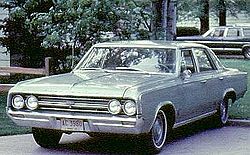
Also called Oldsmobile F-85
Oldsmobile 442Production 1964–1967 Body style 4-door sedan
4-door hardtop
2-door coupe
2-door hardtop
2-door convertible
4-door station wagonLayout FR layout Platform A-body Engine 225 cu in (3.69 L) V6 155 hp
250 cu in (4.1 L) Chevrolet I6 155 hp
330 cu in (5.4 L) V8 230-310 hp
400 cu in (6.6 L) V8 345 hpTransmission 2-speed automatic Wheelbase 115 in (2,900 mm) Length 1964: 203 in (5,200 mm)
1965–67: 204.3 in (5,190 mm)Curb weight 3,440 lb (1,560 kg) Related Oldsmobile Vista Cruiser Disappointing sales of the compact F-85, along with the introduction of Ford Motor Company's intermediate Fairlane in 1962, prompted GM to enlarge the senior compacts for the 1964 model year.
1964
The new intermediate F-85 now rode a conventional body-on-frame chassis with a perimeter frame. Wheelbase grew to 115 inches (2,900 mm), overall length to 203 inches (5,200 mm), and weight by more than 300 pounds (140 kg). Both the aluminum V8 and the Roto Hydramatic were discontinued in favor of a new cast-iron small-block V8 of 330 cu. in. (5.4L) displacement and an optional two-speed Jetaway automatic transmission with variable-pitch stator. Buick's 225 cu. in. (3.7 L) Oddfire V6 was the standard engine.
The body styles of the previous model returned, and a new Vista Cruiser, a stretched-wheelbase (120"/3048 mm) version of the standard station wagon featuring a raised rear roof with tinted skylights and a fold-down, forward-facing third seat, debuted on February 4, 1964. The 442 model, derived from the BO-9 police package, was also introduced in April 1964, as an answer to the new intermediate muscle car market created by the Pontiac GTO that same year.
Sales increased to 167,002 for 1964, not counting Vista Cruisers.
1965
For 1965 a modest facelift increased overall length to 204.3 inches (5,190 mm) while the front end received a "dumbbell-style" grille similar to full-sized Olds models. A bigger 400 cu in (6.6 L) engine was included with the 442 option, based on the newly introduced 425 cu in (6.9 L) engine from the full-sized Oldsmobiles while the Oddfire Buick 225-cubic-inch (3.69 L) V6 and Olds 330 cubic-inch Jetfire Rocket V8 were carried over from the previous year with increased power ratings for the V8 options. Sales increased again to 187,097. The year 1965 was the first for Oldsmobile's "Rocket" logo that would last, with minor variations, until the 1990s.
1966
The 1966 models were slightly restyled again with bodylines similar to the full-sized Olds 88 and semi-fastback rooflines with extended sail panels and tunneled rear windows on Sport (pillared) and Holiday (hardtop) coupes. The Buick V6 was replaced on base models by an Oldsmobile-badged "Action-Line 6" version of Chevrolet's 250 cu in (4.1 L) "Turbo-Thrift" straight-6 engine, while the 330 cu in (5.4 L) Jetfire Rocket V8 continued with power ratings of 250 and 320 horsepower (190 and 240 kW). New that year was the Cutlass Supreme four-door hardtop sedan also dubbed the Holiday Sedan by Oldsmobile, the first such bodystyle for Olds' intermediate line.
1967
Major news for 1967 was the availability of optional disc brakes and the three-speed Turbo-Hydramatic to supplement the two-speed Jetaway. An unusual new model was the Turnpike Cruiser on Cutlass Supreme coupes and convertibles, which used a two-barrel carburetor and mild camshaft with the 400 cu in (6.6 L) engine and a (numerically) low axle ratio for efficient and relatively economical freeway cruising. The Turnpike Cruiser used the heavy-duty suspension of the 442, and was available only with Turbo Hydramatic.
Third Generation - 1968–1972
Third generation 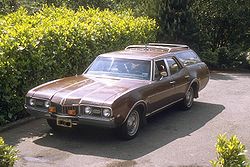
Also called Oldsmobile F-85
Oldsmobile Cutlass Supreme
Oldsmobile 442
Oldsmobile Cutlass CruiserProduction 1968–1972 Body style 4-door sedan
2-door coupe
2-door convertible
2-door hardtop
4-door hardtopLayout FR layout Platform A-body Engine 250 cu in (4.1 L) Chevrolet I6
350 cu in (5.7 L) V8
400 cu in (6.6 L) V8
455 cu in (7.46 L) V8Wheelbase Coupe: 112 in (2,800 mm)
Sedan: 116 in (2,900 mm)Length 201.7 in (5,120 mm) Curb weight 3,515 lb (1,594 kg) Related Oldsmobile Vista Cruiser 1968
The F-85/Cutlass underwent a major body restyle in 1968, as did all other GM A-body cars. Oldsmobile's was penned by the styling studio headed by Stan Wilen. Two-door and four-door models now rode different wheelbases: 112 inches (2,800 mm) for two-doors and 116 inches (2,900 mm) for four-doors. Ostensibly, this change was to allow more individual styling, although several engineers were quoted off the record as saying the 115-inch (2,900 mm) wheelbase had created problems with uncomfortable "freeway hop" owing to its resonance frequency. Overall length shrunk about 2.6 inches (66 mm), but curb weight rose approximately 75 pounds (34 kg) to 3,465 lb (1,572 kg) for the hardtop coupe. Two-door F-85 and Cutlass models adopted a semi-fastback roofline with a massive rear end.
Base model remained the F-85, with mid-level Cutlass S, and upscale Cutlass Supreme, as well as the 442. A limited-production model was the Hurst/Olds, a special 442 marketed by Oldsmobile and Hurst Performance. The H/O combined the 442 suspension package with the big 455 cu. in. (7.4 L) V8, not ordinarily offered in Cutlasses because of a GM policy limiting intermediates to engines of 400 cu. in. (6.6 L) or less. Redesigned base model F-85 and mid-level Vista Cruiser station wagons were also available. F-85 station wagons without the rooftop glass were also available with a 350 CI engine with a 2 barrel carburetor and two-speed Power Glide automatic transmission.
Engine options were similar to the previous year, although the Cutlass's V8 option was expanded to 350 cu. in. (5.7 L). The variable-pitch stator feature of both optional two-speed Jetaway and three-speed Turbo Hydra-matic automatic transmissions was discontinued.
1969
The 1969 F-85/Cutlass models received only minor trim changes from their '68 counterparts such as a now-Olds trademark split grille with vertical bars and vertical taillights. Per federal safety regulations, headrests were now standard equipment and the ignition switch moved from the instrument panel to the steering column to lock the steering wheel when not in use, in common with all other 1969-model GM cars, one year before the locking steering columns were federally mandated.
Engine offerings were unchanged from 1968, but a new three-speed Turbo Hydra-matic 350 transmission was added to the option list and available with all versions of the 350 cu in (5.7 l) Rocket V8, including the standard two-barrel 350 cu in (5.7 l) version, four-barrel "Ultra High Compression" 310 hp (230 kW) option and the W-31 option, conservatively rated at 325 hp (242 kW).[3] The old two-speed Jetaway automatic was still available with the Chevy-built 250 cu in (4.1 l) "Action-Line" six or the two-barrel 350 cu in (5.7 l) V8. The Turnpike Cruiser two-barrel 400 cu in (6.6 l) Rocket V8 was dropped and the four-barrel 400 engine from the 4-4-2 was available only in the Vista Cruiser wagons.
1970
The 1970 Cutlass was available in seven body styles: the base F-85 two door sedan, as well as two door hardtops offered in both notchback Cutlass Supreme and fastback Cutlass S and 442 body styles - a practice similar to Ford and Mercury intermediates of that time, which were offered in both notchback and fastback coupes starting in 1968. Also available were a four door hardtop, four door sedan, a convertible and a flat top station wagon called the Custom Cruiser, as well as the fancier Vista Cruiser station wagon.
With GM tossing out the 400 cubic-inch limit for intermediates and the 4-4-2 now coming standard with the larger 455 cubic-inch Rocket V8 from the big Oldsmobiles and previously used in the 1968-69 Hurst/Olds, Olds discontinued the 400 engine entirely and also offered the 455 as an option in the Cutlass S models and the Vista Cruiser wagons. There was an SX option that became available in 1970 and was available only on the Cutlass Supreme hardtop and convertible. The SX cars all had the 455 engine and TH-400 automatic transmission.
The same assortment of three- and four-speed manual transmissions were carried over from previous years with Hurst shifters used on floor-mounted three-speeds and all four-speeds. The two-speed Jetaway automatic transmission was discontinued entirely with the three-speed Turbo Hydra-matic now the sole offering for shiftless driving. Cutlass S coupes with the optional Strato bucket seats and Turbo Hydra-matic could be equipped with the Hurst Dual-Gate shifter (also known as the "His and her-shifter") in conjunction with the extra-cost center console. The Hurst Dual-Gate made it possible to either put the transmission in Drive, and let the transmission decide when to shift. Or it could be placed in a manual mode, much like todays computer controlled automatics.
curb weight : 4500
1971
The 1971 model shared much of the same exterior sheetmetal as the 1970, but with a new hood, grille, and headlight assemblies, as well as new bumpers and taillights. Four new exterior body colors were offered, Viking Blue, Lime Green, Bittersweet, and Saturn Gold
The famous "Rocket" V8 continued in several different sizes and power options, with both the large 455 and 'small block' 350 available with either 2 or 4 barrel carburetors. This was the last year for the 250 cubic-inch six cylinder engine, as it had not been a very popular offering in Olds intermediates. In 1971, all engines came from the factory with hardened valve seats, preparing for the upcoming mandate for unleaded gasoline that took effect with the introduction of catalytic converters on 1975 models. The 1971 Olds engines also featured lowered compression ratios and designed to run on regular leaded, low-lead or unleaded gasoline with a research octane rating of 91 or higher (equivalent to 87 octane by today's octane measurements).
1972
For 1972, there were minor style changes to the Cutlass, and the 442 reverted back to being a trim line (W-29 option) on the Cutlass instead of an individual model, as it was in 1971.
The primary changes to the 1972 Cutlass were the front grilles and the tail lights.
The new 1972 Hurst/Olds used the Cutlass Supreme notchback hardtop and convertible body. A Hurst/Olds Cutlass 4-4-2 paced the Indianapolis 500, and Olds built about 630 replicas, some 25% of them convertibles.[4] The straight-6 engine was retired temporarily, but returned to the lineup in 1975 following the 1973-74 energy crisis for two model years before it was replaced by a Buick-built 231 cubic-inch V6 in 1977, which was basically the same V6 previously used on some 1964-65 Olds intermediates.
The low-line F-85 series was down to a single four-door sedan and discontinued during the course of the 1972 model year due to low sales. This move also ended the use of the F-85 nameplate that dated back to 1961, although it would resurface a few years later on a base-line version of the compact Omega.
Fourth Generation - 1973–1977
Fourth generation 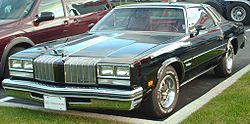
Also called Oldsmobile Cutlass Supreme
Oldsmobile Cutlass Salon
Oldsmobile 442
Oldsmobile Vista Cruiser
Oldsmobile Cutlass CruiserProduction 1973–1977 Assembly Lansing, Michigan; Arlington, Texas; Doraville, Georgia; Framingham, Massachusetts Body style 4-door sedan
5-door station wagon
2-door coupeLayout FR layout Platform A-body Engine 231 cu in (3.79 L) Buick V6
250 cu in (4.1 L) Chevrolet I6
260 cu in (4.3 L) V8
350 cu in (5.7 L) V8
403 cu in (6.60 L) V8
455 cu in (7.46 L) V8Transmission 5-speed manual
4-speed manual
3-speed manual
3-speed automaticWheelbase 112 in (2,800 mm) (coupe)[5]
116 in (2,900 mm) (sedan)Length 207"[6] Width 76.5"[7] 1973
The Cutlass line was redesigned for 1973 using GM's new "Colonnade" A-body platform. The model lineup consisted of the base Cutlass, Cutlass "S", Cutlass Supreme, Cutlass Salon, Vista Cruiser station wagon, and the 442 appearance package on the Cutlass "S" colonnade coupe. The Cutlass "S" and 442 offered, as an extra-cost option, unique Strato bucket seats with high seatbacks and built-in headrests that could be swiveled 90 degrees to permit easier entry and exit for the driver and front-seat passenger.
The new Cutlass Salon was an upscale Euro-style luxury/sports sedan similar in concept to the Pontiac Grand Am of the era. The Salon, which included items such as uprated suspension, radial tires, reclining bucket seats and dimmer switch mounted in the turn-signal lever was based on the Cutlass Supreme series, first as a 4-door Colonnade sedan, joined by a 2-door Colonnade hardtop coupe in 1974. The Cutlass Salon was the first Oldsmobile with the 'international' flags emblem, later carried on the Cutlass Ciera. Front disc brakes were standard.[8]
All Cutlass models came standard with a Template:Conver 350 Rocket V8 (k code). Optionally available was a 200-horsepower (150 kW) 350 rocket V8 with dual exhaust (m code), a 250-horsepower (190 kW) 455 Rocket V8 (U code or L75). The top engine option was a 270-horsepower (200 kW) 455-rocket V8, with a hotter cam, and W30 style heads. This engine was called the L77 (V code), and was used primarily in the 4 speed cars, and automatics without the air conditioning option. Transmissions included a standard column-shift three-speed manual, optional four-speed manual with Hurst shifter or the three-speed Turbo Hydra-matic automatic. Gauges were optional.[9]
1974
Only minor styling changes were made on this year's Cutlass models. Most notable were new grilles up front, including a unique fascia with bumper mounted turn signals on the base model not shared with any of the other trim levels, and federally mandated 5 mph (8.0 km/h) rear bumpers (joining the 5 mph (8.0 km/h) front bumpers mandated in '73) along with flush taillight lenses. Both the 350 and 455 Rocket V8s were carried over unchanged from 1973 aside from revisions required to meet 1974 emission regulations. Turbo Hydra-matic transmission became standard equipment on all Cutlass models this year. A new hydraulic bumper system was new.[10]
1975
For 1975, Oldsmobile added two smaller engines to attract economy-minded buyers in the aftermath of the 1973–74 energy crisis. Those included the Chevrolet-built 250 cubic-inch inline six (previously offered on 1966–71 Olds Cutlasses) and a new 260 V8 based on the Olds 350 Rocket V8, which continued as an option. Also available was the 455 Rocket V8, rated at 190 horsepower (140 kW). All engines were mated to catalytic converters and required unleaded gasoline. The three-speed manual transmission returned as standard equipment in conjunction with the six-cylinder engine on all Cutlass models except Salons and station wagons. However, very few Cutlasses were built with those items as most customers overwhelmingly preferred the 350 V8 and Turbo Hydra-matic as in previous years.
The Cutlass line superseded the full-sized Delta 88 as the best-selling Oldsmobile line for the first time ever in 1975 with the Cutlass Supreme coupe accounting for the majority of those sales, becoming the best-selling intermediate-sized car in America by overtaking the Chevrolet Chevelle and Ford Torino for the top spot. The Cutlass was also the second-best selling car line in the U.S. in 1975, with only the full-sized Chevrolet Impala/Caprice outpacing it. A fuel economy gauge was optional.[11]
1976
The Oldsmobile Cutlass became America's best selling car this year and would hold this title for most years into the 1980s. A restyled front end with waterfall-like split grilles and new rectangular headlights was introduced that would become an Olds Cutlass trademark in coming years, lasting into the late 1980s. The sides were also re-shaped for a less contoured look than the 1973-75 design, the taillights were revised and the license plate/fuel filler was moved above the bumper. The base Cutlass line was dropped, with the Cutlass S nameplate now applied to the entry-level coupe and sedan this year - both of which featured an aerodynamic slanted front nose in contrast to the upright front ends of other Cutlass models including the Cutlass Supreme coupe, sedan and wagon, Vista Cruiser wagon, Cutlass Salon coupe and sedan, and the new Cutlass Supreme Brougham coupe. The 442 option was still offered on Cutlass S coupes as an appearance/handling package.
Engine offerings were carried over from 1975 including the Chevy-built 250 cubic-inch inline six and Olds-built Rocket V8s of 260, 350 or 455 cubic inches. A three-speed manual transmission was standard with the six-cylinder engine but Turbo Hydra-matic was optional with this engine and the 260, and required with the 350 and 455 V8s. A new option this year was a five-speed manual transmission, which was available only with the 260 V8.
1977
New grilles highlighted all 1977 Cutlass models with Cutlass S sedans and coupes reverting back to an upright grille/front end while the more aerodynamic slanted front end was only offered with the 442 option. "Oldsmobile" nameplates in a new sans-serif typeface replaced the former script ones.
Inside was a slightly revised instrument panel with the clock relocated to the right side of the dash above the glovebox. This also marked the introduction of Oldsmobile's new mechanical digital clock. The Chevrolet inline six was replaced by Buick's 231 V6, while the 260 and 350 Rocket V8s were carried over. The big 455 Rocket V8 was discontinued and replaced by a new 403 cubic-inch Rocket V8. Transmission offerings included a three-speed manual (standard with the V6 engine on Cutlass S and Supreme coupes and sedans), five-speed manual (with 260 V8 only) or three-speed Turbo Hydra-matic optional on V6 "S" and Supreme models, and standard equipment on all Cutlass Supreme Brougham, Cutlass Salon and station wagon models, as well as all cars with 350 and 403 V8s.
A sedan was added to the Supreme Brougham line, while the Salon lost its sedan version. The base wagon dropped the Cutlass Cruiser nameplate and became part of the Vista Cruiser line.
632,742 Cutlasses were built in 1977, the highest production for the model.
Fifth-Generation Downsizing
Fifth generation 
Also called Oldsmobile Cutlass Supreme (1978–1988)
Oldsmobile Cutlass Calais (1978–1984)
Oldsmobile Cutlass Salon (1985–1987)
Oldsmobile Cutlass Cruiser (1978–1983)
Oldsmobile 442 (1978–1980)Production 1978–1988 Assembly Sainte-Thérèse, Quebec, Canada Successor Oldsmobile Cutlass Ciera Body style 4-door sedan
4-door fastback sedan
5-door station wagon
2-door coupe
2-door fastback coupeLayout FR layout Platform A-body (1978–81)
G-body (1982–88)Engine 231 cu in (3.79 L) Buick V6
260 cu in (4.3 L) Oldsmobile V8
260 cu in (4.3 L) Oldsmobile diesel V8
301 cubic inches (4.93 L) Pontiac V8
305 cu in (5.00 L) Chevrolet V8Wheelbase 108 in (2,700 mm) Related Buick Century
Chevrolet El Camino
Chevrolet Malibu
Chevrolet Monte Carlo
Pontiac Grand Am
Pontiac Grand Prix
Pontiac LeMans1978
The 1978 Cutlass was downsized to the new version of GM's A-body with a shorter, 108-inch (2,743 mm) wheelbase. This Cutlass was lighter than earlier versions at around 3,300 pounds (1,500 kg), and it could be ordered with any of several engines built by GM's different divisions; a Buick 231 V6, Oldsmobile 455 V8, Pontiac 301 V8 or Chevrolet 305 V8s with either 2 or 4 barrel carburetors.
The '78 Cutlass lineup included the Salon and Salon Brougham fastback coupes and sedans and the formal roof Supreme, Supreme Brougham and Calais coupes. The Salons were styled more like imported hatchbacks than racy fastbacks (although they had a separate trunk), and they quickly proved to be far less popular than the notchback Supreme and Calais coupes. There were also 2-seat (6 passenger) Cutlass Cruiser and Cutlass Cruiser Brougham station wagons; both being smaller, more conventional replacements of the 3-seat (8 passenger) Vista Cruiser. Broughams featured softer, quieter rides, and fancier trim and upholstery. A factory T-top was optional on notchback coupes only. The 4-4-2 appearance and handling package, available on Salon coupes, featured large lower body stripes and 4-4-2 decals outside but not always shown with decals, , unique 4-4-2 seats and badges inside, and a taut performance suspension featuring quicker-ratio steering, heavier springs, stiffer shocks, a stiffer front stabilizer bar, a rear stabilizer bar, and bigger tires. The Cutlass Calais used essentially the same suspension as the 4-4-2, but it also came standard with several other performance and touring options, including full instrumentation, an aluminum spoked sport steering wheel, reclining front bucket seats and a center console with floor shifter. Cosmetically, the 1978 line continued through 1979 with only slight changes front and rear.
1979
The same model lineup continued, with a revision of both the front grille and taillight lenses. A diesel version of the Oldsmobile 260 (based on the Olds 350 diesel) was optional; diesel Cutlasses had the "Oldsmobile Diesel" badges on the decklids, where gasoline-powered Cutlasses had the "Rocket" logo.
Only 2,499 Cutlass Calais coupes were equipped with the Hurst/Olds W-30 package, featuring unique aluminum wheels trimmed with gold paint, an exclusive console-mounted Hurst Dual Gate floor shifter, special gold over black or white two-tone paint and an otherwise unavailable Oldsmobile 350 V8 with 4-barrel carb and dual outlet exhausts. Only 537 cars with the H/O package had T-Tops.
1980
Cutlass Supreme and Calais coupes received new header panels incorporating four headlights, mimicking the 1977 model. The four-door Salon was dropped due to poor sales. Taking its place was a conventional notchback sedan known simply as "Cutlass," with base, LS, and Brougham trim levels available. Sister division Buick did the same with their Buick Century sedan (the 1978 to 1980 Centuries shared the bodyshell with the Cutlass Salon). The 4-4-2 package was moved to the Cutlass Calais, and while it lacked the Dual Gate shifter, it was essentially a carryover of the 1979 Hurst/Olds, even having the Oldsmobile 350 V8.
1981
The fastback Salon coupe was dropped, and the Supreme and Calais got a restyle that included a more aerodynamic nose and smoother body lines. Sedans got quad headlamps and a new grille. The 4-4-2 was dropped.
1982–1997 Oldsmobile Cutlass family
Beginning in 1982, Oldsmobile began to use the Cutlass nameplate as a sub-marque, with a number of different vehicle lines bearing the name simultaneously.
Cutlass Ciera (1982–1996)
The smaller Cutlass Ciera was introduced on GM's new front-wheel drive mid-sized A platform in 1982. The Cutlass Cruiser station wagon nameplate followed the Ciera to its new platform in 1984. Coupes were produced until 1992, sedans and wagons until 1996. For the final year in production, this model was renamed simply Oldsmobile Ciera.
During its run, the Cutlass Ciera was consistently Oldsmobile's best-selling model.
Cutlass Supreme (1982–1997)
1982–1988
Meanwhile, the previous generation Cutlass Supreme continued on the (now renamed) rear wheel drive G platform for six more years. The Hurst/Olds edition reappeared for two years in 1983 and 1984.
Until 1984, the deluxe Cutlass Supreme model was known as the Cutlass Calais. When the Calais nameplate moved to its own platform in 1985, the top Supreme was renamed to Cutlass Salon. As the new Cutlass Supreme model was being launched in 1988, the rear-drive G-special coupe remained in production for one final model year as the Cutlass Supreme Classic.
1988–1997
The premium Cutlass Supreme nameplate was moved to the new front wheel drive mid-sized GM W platform in 1988. Originally a coupe, a 4-door sedan model was added in 1990. Convertibles were also produced from 1990 to 1995.
In 1998, the Cutlass Supreme was replaced by the Oldsmobile Intrigue.
Cutlass Calais (1985–1991)
The third Cutlass nameplate introduced was the compact Cutlass Calais (originally just Oldsmobile Calais) on the front wheel drive N-body in 1985. The famed 442 nameplate was revived for the Cutlass Calais in 1990 and 1991.
The Cutlass Calais was replaced by the Oldsmobile Achieva in 1992.
Sixth Generation
Sixth generation 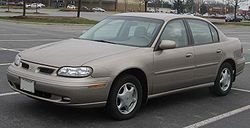
Production 1997–1999 Assembly Oklahoma City, Oklahoma, USA Predecessor Oldsmobile Cutlass Ciera Successor Oldsmobile Alero Body style 4-door sedan Layout FF layout Platform N-body Engine 3.1 L (190 cu in) 3100 V6 Transmission 4-speed automatic Wheelbase 107 in (2,700 mm) Length 190.4 in (4,840 mm) Width 69.4 in (1,760 mm) Height 56.4 in (1,430 mm) Related Chevrolet Malibu
Pontiac Grand Am
Oldsmobile Alero1997–1999
The minimal Oldsmobile Cutlass name was revived in 1997 for an upscale version of the new Chevrolet Malibu, replacing the Oldsmobile Ciera, and was exclusively sold in the United States. Built at the Oklahoma City Assembly plant, this model used the 107 in (2,700 mm) wheelbase GM N platform, shared with the Pontiac Grand Am, Buick Skylark, and Oldsmobile Achieva. This model was a bridge between Oldsmobile's Achieva and Alero models, making this a placeholder model. It was also later regarded as a stop-gap measure to give Oldsmobile a model to sell below the larger Intrigue until the new Alero (also on the N platform) arrived in 1999.
Essentially similar to the Chevy Malibu of this generation, it did differ in its Oldsmobile split-grille fascia, all red rear tail lamps, and its unique optional chrome wheels. Its base model also offered more standard equipment than the Malibu, like a split-folding rear seat and power locks. However, it shares the same mechanical and design features as its twin.
Production of the N-body Cutlass ended July 2, 1999, marking it as the last car to bear the Cutlass name. It was replaced by the Alero. The Alero also replaced the smaller but related Achieva.
Engine:
- 1997–1999 3100 (191 cu in or 3.13 L) V6, 160 bhp (119.3 kW) and 185 lbf·ft (251 N·m)
References
- ^ http://www.oldcarbrochures.com/static/NA/Oldsmobile/1961%20Oldsmobile/1961_Oldsmobile_Full_Line_Brochure/1961%20Oldsmobile%20Full%20Line-30-31.html
- ^ http://www.oldcarbrochures.com/static/NA/Oldsmobile/1961%20Oldsmobile/1961_Oldsmobile_Full_Line_Brochure/1961%20Oldsmobile%20Full%20Line-24-25.html
- ^ Hot Rod, 3/86, p.54.
- ^ Flory, J. "Kelly", Jr. American Cars 1960-1972 (Jefferson, NC: McFarland & Coy, 2004), p.864.
- ^ http://www.oldcarbrochures.com/static/NA/Oldsmobile/1973_Oldsmobile/1973_Oldsmobile_Full_Line_Brochure/1973%20Oldsmobile%20Full%20Line-34-35.html
- ^ http://www.oldcarbrochures.com/static/NA/Oldsmobile/1973_Oldsmobile/1973_Oldsmobile_Full_Line_Brochure/1973%20Oldsmobile%20Full%20Line-34-35.html
- ^ http://www.oldcarbrochures.com/static/NA/Oldsmobile/1973_Oldsmobile/1973_Oldsmobile_Full_Line_Brochure/1973%20Oldsmobile%20Full%20Line-34-35.html
- ^ http://www.oldcarbrochures.com/static/NA/Oldsmobile/1973_Oldsmobile/1973_Oldsmobile_Full_Line_Brochure/1973%20Oldsmobile%20Full%20Line-34-35.html
- ^ http://www.oldcarbrochures.com/static/NA/Oldsmobile/1973_Oldsmobile/1973_Oldsmobile_Full_Line_Brochure/1973%20Oldsmobile%20Full%20Line-34-35.html
- ^ http://www.oldcarbrochures.com/static/NA/Oldsmobile/1974_Oldsmobile/album/1974%20Oldsmobile-37.html
- ^ http://www.oldcarbrochures.com/static/NA/Oldsmobile/1975%20Oldsmobile/1975%20Oldsmobile%20Full%20Line%20Brochure/75%20Oldsmobile%20Pg%2030.html
External links
Oldsmobile road car timeline, Post WW2–1970s — next » Type 1940s 1950s 1960s 1970s 6 7 8 9 0 1 2 3 4 5 6 7 8 9 0 1 2 3 4 5 6 7 8 9 0 1 2 3 4 5 6 7 8 9 Subcompact Starfire Compact F-85 Omega Mid-size 66/68 F-85 F-85 Vista Cruiser Vista Cruiser Vista Cruiser Cutlass Cruiser 76/78 Cutlass Cutlass Cutlass Cutlass Full-size 88 88 88 88 88 88 88 88 98 98 98 98 98 98 98 98 98 Custom Cruiser Custom Cruiser Personal luxury Toronado Toronado Toronado « previous — Oldsmobile road car timeline, 1980s–2004 Type 1980s 1990s 2000s 0 1 2 3 4 5 6 7 8 9 0 1 2 3 4 5 6 7 8 9 0 1 2 3 4 Compact Starfire Firenza Omega Cutlass Calais Achieva Alero Mid-size Cutlass Cutlass Ciera Cutlass Cutlass Cruiser Cutlass Cruiser Cutlass Supreme Cutlass Supreme Intrigue Full-size Eighty-Eight Eighty-Eight Eighty-Eight Ninety-Eight Ninety-Eight Ninety-Eight Regency Custom Cruiser Custom Cruiser LSS Aurora Aurora Personal luxury Toronado Toronado Minivan Silhouette Silhouette SUV Bravada Bravada Bravada Categories:- Oldsmobile vehicles
- Front wheel drive vehicles
- Rear wheel drive vehicles
- Compact cars
- Mid-size cars
- Convertibles
- Coupes
- Muscle cars
- Sedans
- Hatchbacks
- Station wagons
- 1960s automobiles
- 1970s automobiles
- 1980s automobiles
- 1990s automobiles
- Vehicles introduced in 1961
Wikimedia Foundation. 2010.





